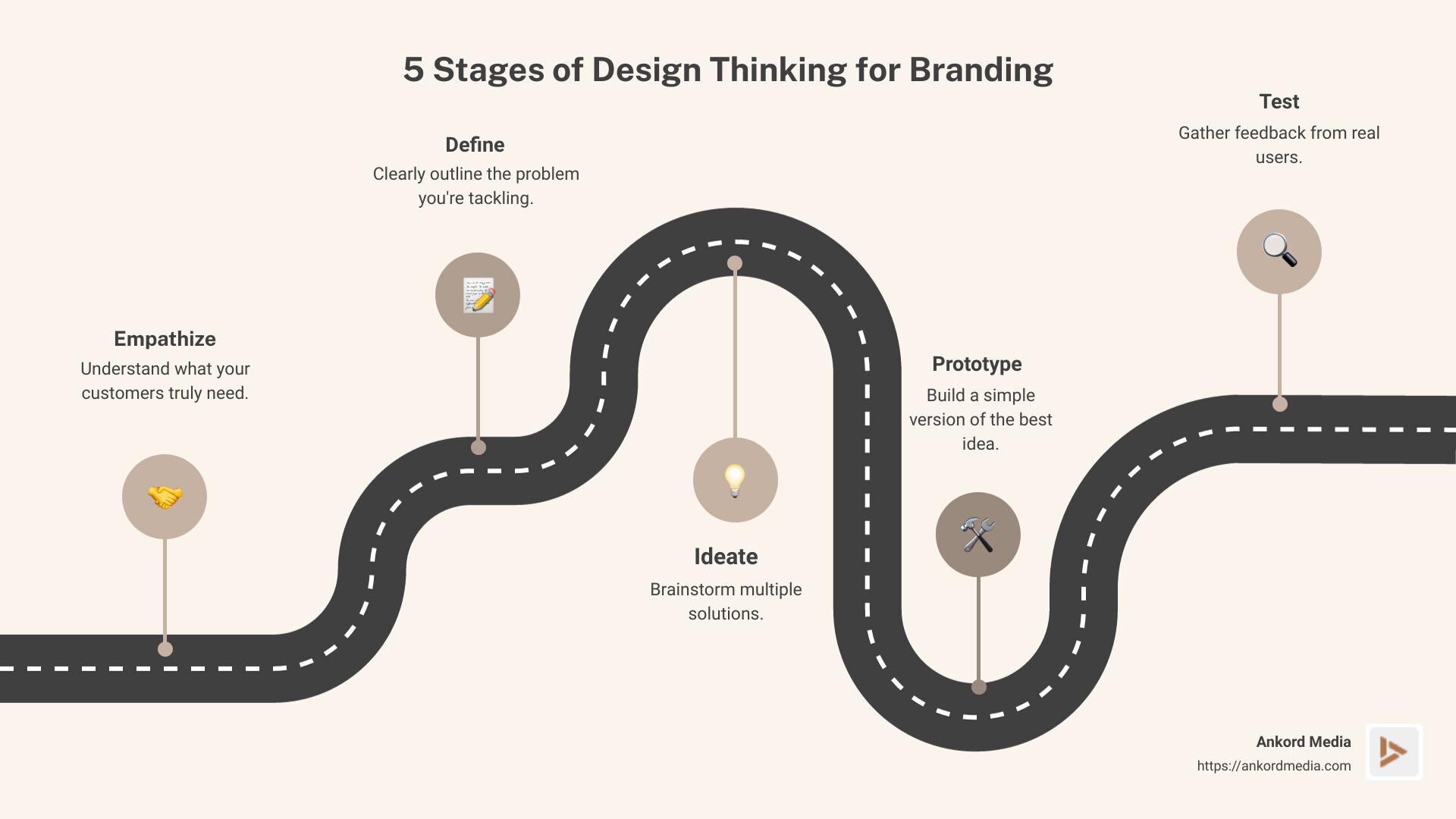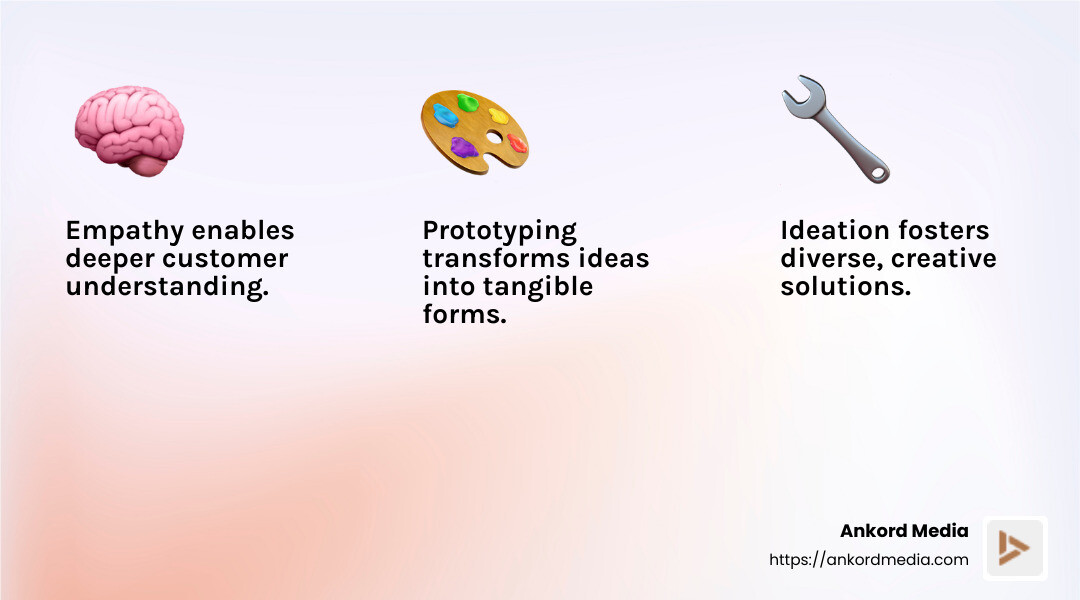Unlocking Brand Potential: A Design Thinking Approach

Design thinking for branding is a game changer in brand development. It takes a customer-focused approach to innovation, turning complex problems into simple solutions. Here's how it works:
- Empathize: Understand what your customers truly need.
- Define: Clearly outline the problem you're tackling.
- Ideate: Brainstorm multiple solutions.
- Prototype: Build a simple version of the best idea.
- Test: Gather feedback from real users.
By following these steps, you can craft a brand that resonates deeply with your audience and stays ahead of the competition. Now, let's explore how this approach can open up your brand's potential.
I'm Milan Kordestani, a Gen Z entrepreneur passionate about design thinking for branding. Growing up in Silicon Valley, I witnessed the birth of iconic brands, fueling my journey to bridge business and design. As CEO of Ankord Media, I specialize in turning visionary ideas into remarkable brand experiences.

Understanding Design Thinking for Branding
Design thinking for branding is all about creating a brand that truly connects with people. It's not just about logos or colors. It's about understanding your customers and designing a brand that speaks to them.
Human-Centered Approach
At its core, design thinking is human-centered. This means putting people first. By focusing on customer experiences, you can craft a brand that feels personal and relevant. This approach helps you see things from your customer's perspective, making your brand more relatable.
Empathy: The Starting Point
Empathy is the foundation of design thinking. It's about understanding your customers' emotions, needs, and desires. By putting yourself in their shoes, you can create a brand that truly resonates. For example, UberEats uses empathy to tailor services to different locations, solving specific problems for their users.
"Understanding pain points helps solve problems effectively."

Ideate: Generating Creative Ideas
Once you've empathized with your audience, it's time to ideate. This is where creativity comes into play. Gather a diverse team and brainstorm a wide range of ideas. The goal is to think outside the box and explore all possibilities.
Prototype: Bringing Ideas to Life
After narrowing down your ideas, it's time to prototype. This involves creating a simple version of your branding concept. It could be a mock-up of a logo, a draft of a marketing message, or a sketch of a new product. Prototyping helps you visualize your ideas and identify any flaws before going public.
Test: Gathering Feedback
Finally, the test phase is crucial. Share your prototype with real users and gather their feedback. Listen to what they like and what they don't. This iterative process lets you refine your brand and ensure it meets your customers' needs.
By using a human-centered approach and following these steps, you can create a brand that truly stands out. Next, we'll dive deeper into how you can apply these principles to your branding efforts.
The 5 Stages of Design Thinking
Design thinking is a structured process that helps you create brands people love. Let's break down the five key stages: empathize, define, ideate, prototype, and test.
Empathize: Understanding Your Audience
The first step is to empathize with your audience. This means getting to know their needs, desires, and emotions. By understanding what makes your customers tick, you can design a brand that truly resonates with them. For instance, companies like UberEats use empathy to adapt their services to different locations, effectively addressing specific user concerns.
Define: Pinpointing the Problem
Once you've gathered insights, it's time to define the problem. This involves reframing your understanding of your customer's challenges into a clear problem statement. Knowing exactly what you're solving helps focus your branding efforts and ensures you're on the right track.
Ideate: Exploring Creative Solutions
With a clear problem statement in hand, you move to the ideate stage. Here, creativity takes center stage. Gather a diverse team and brainstorm as many ideas as possible. The aim is to generate innovative solutions that address the defined problem. No idea is too wild at this point!
Prototype: Building Tangible Concepts
Next, it's time to prototype. Create simple, tangible versions of your ideas. These can be mock-ups, sketches, or even digital models. Prototyping allows you to explore how your ideas might work in the real world and spot potential issues early on. Prototypes don't need to be perfect—they just need to convey the concept.
Test: Refining Through Feedback
The final stage is to test your prototypes with real users. Gather feedback to understand what works and what doesn't. This step is crucial for refining your brand concept and ensuring it aligns with customer needs. Testing is an iterative process—expect to make adjustments based on what you learn.
By following these five stages, you can create a brand that not only meets but exceeds customer expectations. In the next section, we'll explore how to apply these principles to your branding efforts.
Applying Design Thinking in Branding
Design thinking is a powerful tool for branding because it focuses on understanding and meeting customer needs. This approach helps you build a strong brand identity and come up with creative solutions that resonate with your audience.
Understanding Customer Needs
At the heart of design thinking is empathy. To create a brand that stands out, you must deeply understand your customers' needs and preferences. This means going beyond basic demographics and diving into what truly matters to them—what problems they face, what they value, and what they aspire to.
For example, Sephora successfully used design thinking by observing how customers interacted with their website. They finded that users were leaving the site to watch product demos on YouTube. By creating their own line of demonstration videos, Sephora kept customers engaged and increased the likelihood of purchases.
Building a Strong Brand Identity
Once you understand your customers, it's time to align your brand identity with their needs. This involves defining what your brand stands for and how it communicates with your audience. A strong brand identity should be consistent across all touchpoints—whether it's your website, packaging, or customer service.
Design thinking encourages you to continuously refine your brand identity based on feedback and insights. This iterative process ensures that your brand remains relevant and resonates with your audience over time.
Generating Creative Solutions
Design thinking fosters creativity by encouraging diverse perspectives and open-minded brainstorming. When applied to branding, this means exploring a wide range of ideas to solve customer problems and improve their experience with your brand.
Consider the case of Shimano, a bicycle components manufacturer. By using design thinking, they uncovered barriers that kept adults from cycling. This insight led to the creation of the "Coasting" brand concept, which made cycling more accessible and enjoyable for adults.
Implementing and Testing Solutions
Finally, design thinking involves prototyping and testing your ideas. By creating simple prototypes of your branding concepts, you can gather valuable feedback from real users and refine your solutions. This step ensures that your branding efforts are effective and aligned with customer expectations.
Incorporating design thinking into your branding strategy helps you create a brand that not only meets customer needs but also stands out in a competitive market. Next, we'll explore the benefits of using design thinking in branding.
Benefits of Design Thinking for Branding
Enhancing Customer Satisfaction
Design thinking is all about putting the customer first. By focusing on their needs and desires, brands can create products and experiences that truly resonate. This approach leads to increased customer satisfaction because it ensures that every touchpoint with the brand is custom to meet the customer's expectations.
For instance, companies like Disney have used design thinking to revolutionize customer experiences. When faced with long lines and high costs at their theme parks, Disney implemented the MagicBand system. This innovation reduced wait times and improved overall satisfaction, demonstrating how a customer-centric approach can transform a brand's interaction with its audience.
Gaining a Competitive Advantage
Incorporating design thinking for branding can give businesses a significant edge over their competitors. Design-led companies have been shown to outperform their peers by a wide margin. According to the Design Management Institute, design-led companies outperformed the S&P 500 by 228% over a decade. This statistic highlights how a focus on design can lead to superior financial performance.
By understanding and anticipating customer needs, brands can create unique offerings that differentiate them in the market. This competitive advantage is crucial in industries where innovation and customer experience are key drivers of success.
Driving Innovation
Design thinking fosters a culture of innovation by encouraging teams to explore a broad range of ideas and solutions. This approach is not just about incremental improvements; it's about reimagining what's possible. Companies like Nintendo have leveraged design thinking to create groundbreaking products like the Wii, which offered a new and inclusive gaming experience.
By using design thinking, brands can open up new opportunities for growth and differentiation. This process allows them to identify unmet customer needs and develop creative solutions that set them apart from competitors.
Conclusion
Design thinking offers numerous benefits for branding, including improved customer satisfaction, a competitive advantage, and a drive for innovation. By focusing on the customer and fostering a culture of creativity, brands can create meaningful and lasting connections with their audience. In the next section, we'll address some common questions about design thinking for branding.
Frequently Asked Questions about Design Thinking for Branding
What is design thinking in branding?
Design thinking in branding is a method that places the user at the heart of the process. It involves understanding the customer's needs and emotions to create a brand that resonates with them. This approach is structured around five key stages: empathize, define, ideate, prototype, and test.
- Empathize: Dive deep into understanding your customers. What are their needs, desires, and pain points? This stage is all about walking in their shoes to gather insights that will inform your branding efforts.
- Define: Clearly articulate the problem you're addressing. This means framing a problem statement that captures the essence of what your brand needs to solve for its audience.
- Ideate: Generate a range of creative solutions. This brainstorming phase encourages out-of-the-box thinking to explore multiple avenues for brand development.
- Prototype: Develop tangible representations of your ideas. Prototypes can be anything from sketches to models that help visualize how your branding concepts might work in the real world.
- Test: Gather feedback by testing these prototypes with real users. This stage is crucial for refining your brand strategy based on actual user interactions and reactions.
How is design thinking used in marketing?
Design thinking is a powerful tool for problem-solving in marketing. It emphasizes understanding the customer journey and creating marketing strategies that appeal directly to the target audience. By empathizing with customers, marketers can identify what truly matters to them and tailor campaigns that resonate on a personal level.
For example, GE Healthcare used design thinking to transform MRI experiences for children by turning intimidating machines into engaging pirate ships. This approach not only improved the customer experience but also improved patient outcomes.
What is the design process for branding?
The design process for branding, often referred to as brand findy and brand identity, involves creating a cohesive and compelling brand image that speaks to your target market.
- Brand Findy: This is about finding the unique aspects of your brand that will set it apart from competitors. It involves identifying core values, mission, and vision that align with customer expectations.
- Brand Identity: This encompasses the visual and emotional elements that define your brand, such as logos, color schemes, and tone of voice. It's about creating a consistent and memorable presence across all customer touchpoints.
By following the design thinking stages, brands can continuously refine and evolve their identity to stay relevant and engaging in a rapidly changing market.
Conclusion
At Ankord Media, we believe that strategic branding is more than just a logo or a catchy slogan. It's about crafting an authentic narrative that resonates with your audience and drives meaningful connections. This is where design thinking for branding becomes a game-changer.
Design thinking allows us to dive deep into the psyche of our audience, uncovering insights that shape every element of our clients' brands. By empathizing with the end user, we create brands that not only meet customer needs but also evoke emotions and foster loyalty.
Our approach combines strategic branding with impactful storytelling. We leverage our expertise in design and technology to transform bold ideas into successful realities. This holistic approach ensures that every touchpoint, from digital experiences to visual storytelling, aligns with the brand's core values and mission.
Through design thinking, we help brands not just to adapt but to thrive in an changing marketplace. By continuously iterating and testing, we ensure that our branding strategies are not only innovative but also deeply rooted in customer insights.
If you're ready to open up your brand's potential and build a lasting connection with your audience, explore how Ankord Media can help. Together, we can turn your visionary ideas into tangible success.

